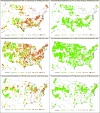Geographic Variation in Trends and Disparities in Acute Myocardial Infarction Hospitalization and Mortality by Income Levels, 1999-2013
- PMID: 27438103
- PMCID: PMC5459393
- DOI: 10.1001/jamacardio.2016.0382
Geographic Variation in Trends and Disparities in Acute Myocardial Infarction Hospitalization and Mortality by Income Levels, 1999-2013
Abstract
Importance: During the past decade, the incidence and mortality associated with acute myocardial infarction (AMI) in the United States have decreased substantially. However, it is unknown whether these improvements were consistent across communities of different economic status and geographic regions since efforts to improve cardiovascular disease prevention and management may have had variable impact.
Objective: To determine whether trends in US county-level, risk-standardized AMI hospitalization and mortality rates varied by county-based median income level.
Design, setting, and participants: In this observational study, county-level risk-standardized (age, sex, and race) hospitalization and 1-year mortality rates for AMI from January 1, 1999, to December 31, 2013, were measured for Medicare beneficiaries 65 years or older. Data analysis was performed from June 2 through December 1, 2015. Counties were stratified by median income percentile using 1999 US Census Bureau data adjusted for inflation: low- (<25th), average- (25th-75th), or high- (>75th) income groups.
Main outcomes and measures: The effect of income on the slope of AMI hospitalizations and mortality, measured as differences in the rate of change in AMI hospitalizations and mortality by county income and by the 4 US geographic regions, and a possible lag effect among low-income counties.
Results: In the 15-year study period, AMI risk-standardized hospitalization and mortality rates decreased significantly for all 3 county income groups. Mean hospitalization rates were significantly higher among low-income counties compared with high-income counties in 1999 (1353 vs 1123 per 100 000 person-years, respectively) and in 2013 (853 vs 648 per 100 000 person-years, respectively). One-year mortality rates after hospitalization for AMI were similar across county income groups, decreasing from 1999 (31.5%, 31.4%, and 31.1%, for high-, average-, and low-income counties, respectively) to 2013 (26.2%, 26.1%, and 25.4%, respectively). Income was associated with county-level, risk-standardized AMI hospitalization rates but not mortality rates. Increasing 1 interquartile range of median county consumer price index-adjusted income ($12 000) was associated with a decline in 46 and 37 hospitalizations per 100 000 person-years for 1999 and 2013, respectively; interaction between income and time was 0.56. The rate of decline in AMI hospitalizations was similar for all county income groups; however, low-income counties lagged behind high-income counties by 4.3 (95% CI, 3.1-5.9) years. There were no significant differences in trends across geographic regions.
Conclusions and relevance: Hospitalization and mortality rates of AMI declined among counties of all income levels, although hospitalization rates among low-income counties lag behind those of the higher income groups. These findings lend support for a more targeted, community-based approach to AMI prevention.
Figures






Comment in
-
Looking Beyond the Hospital to Reduce Acute Myocardial Infarction: Progress and Potential.JAMA Cardiol. 2016 Jun 1;1(3):251-3. doi: 10.1001/jamacardio.2016.0544. JAMA Cardiol. 2016. PMID: 27438101 No abstract available.
Similar articles
-
Twenty-Year Trends in Outcomes for Older Adults With Acute Myocardial Infarction in the United States.JAMA Netw Open. 2019 Mar 1;2(3):e191938. doi: 10.1001/jamanetworkopen.2019.1938. JAMA Netw Open. 2019. PMID: 30874787 Free PMC article.
-
National trends in recurrent AMI hospitalizations 1 year after acute myocardial infarction in Medicare beneficiaries: 1999-2010.J Am Heart Assoc. 2014 Sep 23;3(5):e001197. doi: 10.1161/JAHA.114.001197. J Am Heart Assoc. 2014. PMID: 25249298 Free PMC article.
-
Trends in 10-Year Outcomes Among Medicare Beneficiaries Who Survived an Acute Myocardial Infarction.JAMA Cardiol. 2022 Jun 1;7(6):613-622. doi: 10.1001/jamacardio.2022.0662. JAMA Cardiol. 2022. PMID: 35507330 Free PMC article.
-
Trends and Disparities in Acute Myocardial Infarction-Related Mortality Among U.S. Adults With Hypertension, 2000-2023.Clin Cardiol. 2025 Apr;48(4):e70129. doi: 10.1002/clc.70129. Clin Cardiol. 2025. PMID: 40259707 Free PMC article. Review.
-
An Ecological Evaluation of Vinyl Chloride Exposure and Liver Cancer Incidence and Mortality in Texas.J Clin Transl Hepatol. 2021 Feb 28;9(1):99-105. doi: 10.14218/JCTH.2020.00073. Epub 2020 Dec 30. J Clin Transl Hepatol. 2021. PMID: 33604260 Free PMC article. Review.
Cited by
-
Geographic Variation in Process and Outcomes of Care for Patients With Acute Myocardial Infarction in China From 2001 to 2015.JAMA Netw Open. 2020 Oct 1;3(10):e2021182. doi: 10.1001/jamanetworkopen.2020.21182. JAMA Netw Open. 2020. PMID: 33095248 Free PMC article.
-
Association of short-term hospital-level outcome metrics with 1-year mortality and recurrence for US Medicare beneficiaries with ischemic stroke.PLoS One. 2023 Aug 10;18(8):e0289790. doi: 10.1371/journal.pone.0289790. eCollection 2023. PLoS One. 2023. PMID: 37561680 Free PMC article.
-
Development of algorithms for identifying fatal cardiovascular disease in Medicare claims.Pharmacoepidemiol Drug Saf. 2018 Jul;27(7):740-750. doi: 10.1002/pds.4421. Epub 2018 Mar 14. Pharmacoepidemiol Drug Saf. 2018. PMID: 29537120 Free PMC article.
-
Geographic Variation in Diagnostic Ability and Quality of Care Metrics: A Case Study of Ankylosing Spondylitis and Low Back Pain.Inquiry. 2017 Jan 1;54:46958017707873. doi: 10.1177/0046958017707873. Inquiry. 2017. PMID: 28548005 Free PMC article.
-
Incidence and all-cause mortality for hip fracture in comparison to stroke, and myocardial infarction: a fifteen years population-based longitudinal study.Endocrine. 2017 Nov;58(2):320-331. doi: 10.1007/s12020-017-1423-1. Epub 2017 Sep 20. Endocrine. 2017. PMID: 28933053
References
-
- Cooper R, Cutler J, Desvigne-Nickens P, et al. Trends and Disparities in Coronary Heart Disease, Stroke, and Other Cardiovascular Diseases in the United States Findings of the National Conference on Cardiovascular Disease Prevention. Circulation. 2000;102(25):3137–47. - PubMed
-
- Diez Roux AV, Merkin SS, Arnett D, et al. Neighborhood of residence and incidence of coronary heart disease. N Engl J Med. 2001;345(2):99–106. - PubMed
-
- Alter DA, Chong A, Austin PC, et al. Socioeconomic Status and Mortality after Acute Myocardial Infarction. Ann Intern Med. 2006;144(2):82–93. - PubMed
Publication types
MeSH terms
Grants and funding
LinkOut - more resources
Full Text Sources
Other Literature Sources
Medical
Miscellaneous

